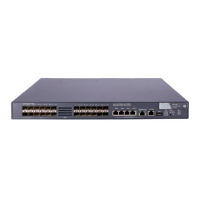17
Figure 10 Daisy chain topology versus ring topology
Binding physical ports to IRF ports
To establish an IRF connection between two devices, you must bind at least one physical port to
IRF-port 1 on one device and to IRF-port 2 on the other. For link redundancy and load sharing, bind
multiple physical ports to one IRF port.
When you bind physical ports to IRF ports, follow the restrictions in "IRF port binding restrictions."
On a p
hysical port that has been bound to an IRF port, you can only use the cfd, default, shutdown,
description, and flow-interval commands. For more information about these commands, see Layer
2—LAN Switching Command Reference.
To bind physical ports to IRF ports:
Step Command Remarks
1. Enter system view.
system-view
N/A
2. Enter Ethernet interface
view or interface range
view.
• Enter interface range view:
{ Approach 1:
interface range
{ interface-type
interface-number [ to
interface-type
interface-number ] }
&<1-5>
{ Approach 2:
interface range name
name [ interface
{ interface-type
interface-number [ to
interface-type
interface-number ] }
&<1-5> ]
• Enter interface view:
interface interface-type
interface-number
To shut down a range of physical
IRF ports, enter interface range
view.
To shut down one physical IRF port,
enter its interface view.
IRF
Ring topology
Subordinate Subordinate
Master
IRF-Port1 IRF-Port2
IRF-Port1
IRF-Port2IRF-Port1
IRF-Port2
Daisy chain
topology
IRF
Master
Subordinate
Subordinate
IRF-Port2
IRF-Port2
IRF-Port1
IRF-Port1

